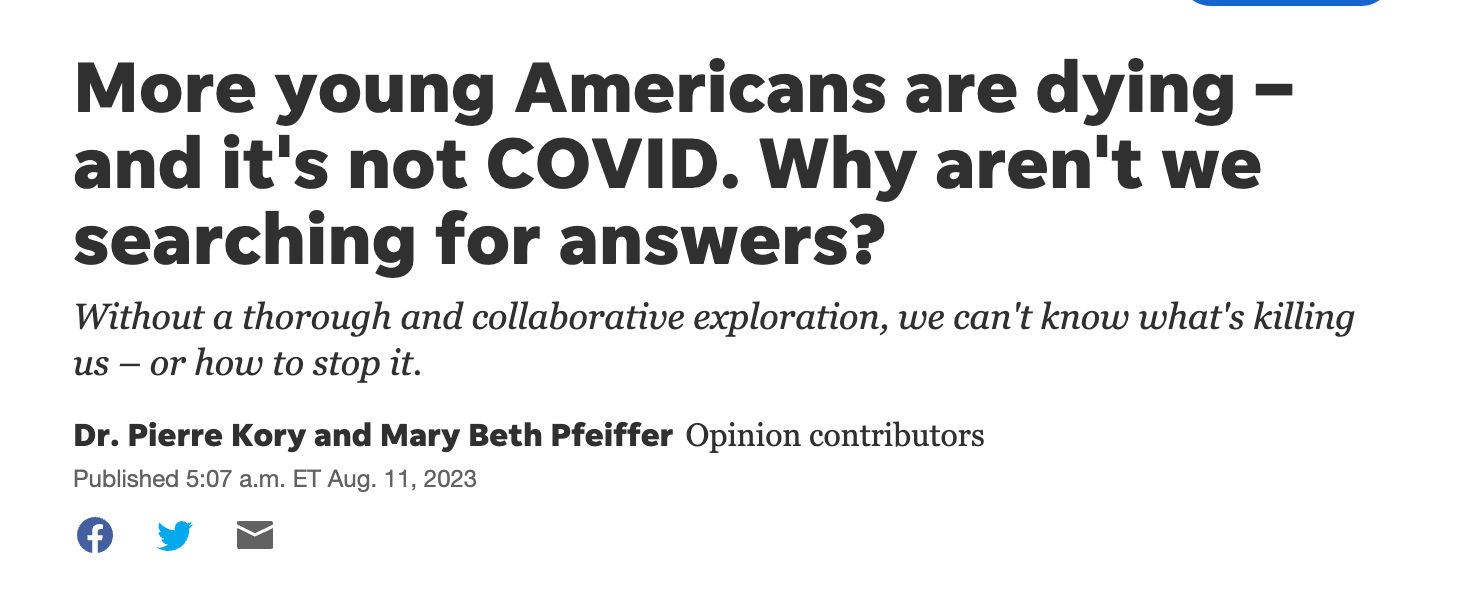Something strange began happening in the autumn of 2021. According to life insurers, excess deaths—the number of people dying beyond what is considered normal—inexplicably shot up. This mysterious spike in deaths happened even as deaths from COVID-19 decreased, and not just among the elderly or infirm, but among younger, working, prime-of-life people.
Writing in USA Today, Dr. Kory and Mary Beth Pfeiffer explore this trend and ask the question: what is killing people?
Among working people 35 to 44 years old, a stunning 34% more died than expected in the last quarter of 2022, with above-average rates in other working-age groups too. "COVID-19 claims do not fully explain the increase," the Society of Actuaries said in a comprehensive new report.
From 2020 through 2022, there were far more excess deaths proportionally among white collar than blue collar workers—19% versus 14% above normal. The disparity nearly doubled among top-echelon workers in the fourth quarter of 2022, U.S. actuaries reported. And there was an extreme and sudden increase in worker mortality in the fall of 2021 even as the nation saw a precipitous drop in COVID-19 deaths from a previous wave. In the third quarter of 2021, deaths among workers 35 to 44 years old reached a pandemic peak of 101% above—or double—the three-year pre-COVID-19 baseline. In two other prime working-age groups, mortality was 79 % above expected.
But it isn't only happening in the United States. The United Kingdomalso saw "more excess deaths in the second half of 2022 than…any year since 2010," according to the Institute and Faculty of Actuaries. In the first quarter of 2023, deaths among people 20 to 44 years old were akin to "the same period in 2021, the worst pandemic year for that age group," U.K. actuaries reported. Younger-age death rates were "particularly high" when compared to the average mortality for 2013 to 2020.
Week-in, week-out, this unnatural loss of life is on the scale of a war or terrorist event.
In Australia, 12% more people died than expected in 2022, according to that nation's Actuaries Institute. A third of the excess was non-COVID-19 deaths, a figure the institute called "extraordinarily high."
Death rates are lower, of course, than in 2020 and 2021. But they are far from normal.
In the year ending April 30, 2023—14 months after the last of four pandemic waves in the U.S.— over 104,000 more Americans died than expected, according to the data tracker, Our World in Data. In the U.K., 52,427 excess deaths were reported in that period; in Germany, 81,028; France, 17,731; Netherlands, 10,418; and Ireland, 2,640.
Week-in, week-out, this unnatural loss of life is on the scale of a war or terrorist event. The actuarial reports can only speculate on the factors causing these deaths, including oft-cited delayed healthcare, drug overdoses, and even weather patterns. But the question remains: what explains this ongoing wave of excess deaths?
…Governments and regulatory agencies should cooperate with life insurers to investigate this trend at the national and multinational level. Without a thorough and collaborative exploration, we can't know what's killing us – or how to stop it.

No comments:
Post a Comment